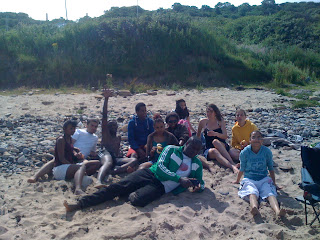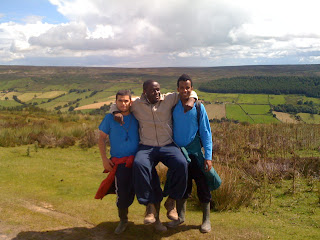

Following the winding road from Thirsk past the spectacular ruins of Riveaulx Abbey the scenery gives a flavour of fairytale England with flower ringed stone cottages, quaint hilltop churches, Postman Pat and Lord of the Manor. For a few weeks this summer I have found myself as a part time mini-bus driver, roaming the North Yorkshire Moors.


The
bus chugs up the caravan route around Sutton Bank and the hills drop away to
reveal the vast splendour of a rolling green plateau. Taking a sharp left at
the village of Helmsley we go from rural to wild, heading due North and
climbing onto the moors, a dramatic sweeping patchwork of purples, greens and
browns. The lane is busy with awkward sheep, scattering white fluffy bottomed
rabbits and plump pheasants fattened by the local gamekeepers. £10,000 a pop for a shooting weekend in these
parts where a faded landed gentry clings onto a glorious past.
 As we shunt into the hidden valley-head of Bransdale my passengers’ eyes are bulging. One young man tells me that he has never been out of the city since arriving in the UK from Africa and our secret destination certainly provides a contrast from the inner-city.
As we shunt into the hidden valley-head of Bransdale my passengers’ eyes are bulging. One young man tells me that he has never been out of the city since arriving in the UK from Africa and our secret destination certainly provides a contrast from the inner-city.
 Bransdale
Mill is an 18th Century watermill owned and maintained by the
National Trust, rebuilt in 1842 its strong sandstone walls and perfectly carved
orange arches still stand strong. The
mill stream gushes past, the colour of Guinness from the iron on the moor. On my first visit I learn from a wise man about
the mechanics of the mill; the old millrace where the river was redirected into
a sluice to power the glorious mill wheel, now rusted into disrepair. Strangely
familiar technical words that dwell in a historical literary world in my mind.
Other curious features huddle around the grounds, a well house, the miller’s
cottage, an old smithy and a sun-dial.
Bransdale
Mill is an 18th Century watermill owned and maintained by the
National Trust, rebuilt in 1842 its strong sandstone walls and perfectly carved
orange arches still stand strong. The
mill stream gushes past, the colour of Guinness from the iron on the moor. On my first visit I learn from a wise man about
the mechanics of the mill; the old millrace where the river was redirected into
a sluice to power the glorious mill wheel, now rusted into disrepair. Strangely
familiar technical words that dwell in a historical literary world in my mind.
Other curious features huddle around the grounds, a well house, the miller’s
cottage, an old smithy and a sun-dial.
 From
its base in Vauxhall in Central London, Refugee Youth has now found a second
summer home here in Bransdale. Despite
its remoteness this summer base is accessible from the urban centres of Leeds
and Middlesborough. The mill serves as a
place to revitalise the spirits of weary city dwellers including myself, a
place for strained youth workers to re-group and a secluded haven of music,
food, friendship and creativity.
From
its base in Vauxhall in Central London, Refugee Youth has now found a second
summer home here in Bransdale. Despite
its remoteness this summer base is accessible from the urban centres of Leeds
and Middlesborough. The mill serves as a
place to revitalise the spirits of weary city dwellers including myself, a
place for strained youth workers to re-group and a secluded haven of music,
food, friendship and creativity.

 After
an evening treasure hunt and toasting marshmallows in the bonfire I have a
fitful night’s sleep in my tent, punctuated by the cheers from the limbo
competition, the rushing river and hysterical bleating sheep at dawn. Then we head in the bus over the hills to the
coast and Runsdale Bay for an afternoon of games on the beach and swimming in
the icy North Sea. We spend the evening
playing games and dancing the ‘Jungle Skank’.
Toasting marshmallows on the bonfire I enjoy chatting to new friends
from London, Leeds, Leicester, Eritrea, Somalia, Nigeria, Cameroon, Iraq and
Afghanistan.
After
an evening treasure hunt and toasting marshmallows in the bonfire I have a
fitful night’s sleep in my tent, punctuated by the cheers from the limbo
competition, the rushing river and hysterical bleating sheep at dawn. Then we head in the bus over the hills to the
coast and Runsdale Bay for an afternoon of games on the beach and swimming in
the icy North Sea. We spend the evening
playing games and dancing the ‘Jungle Skank’.
Toasting marshmallows on the bonfire I enjoy chatting to new friends
from London, Leeds, Leicester, Eritrea, Somalia, Nigeria, Cameroon, Iraq and
Afghanistan.
 Young people from the local farms visit Bransdale and join in the music and fun brought to
the dale from London. Young Londoners
visit local youth groups and farms on the moor to learn how to shear sheep and
build dams. The mill is facilitating new friendships, growing new projects and
rejuvenating its visitors. Refugee Youth
has injected a surreal and exuberant splash of colour into this secret magical
northern quarter.
Young people from the local farms visit Bransdale and join in the music and fun brought to
the dale from London. Young Londoners
visit local youth groups and farms on the moor to learn how to shear sheep and
build dams. The mill is facilitating new friendships, growing new projects and
rejuvenating its visitors. Refugee Youth
has injected a surreal and exuberant splash of colour into this secret magical
northern quarter.
 As we shunt into the hidden valley-head of Bransdale my passengers’ eyes are bulging. One young man tells me that he has never been out of the city since arriving in the UK from Africa and our secret destination certainly provides a contrast from the inner-city.
As we shunt into the hidden valley-head of Bransdale my passengers’ eyes are bulging. One young man tells me that he has never been out of the city since arriving in the UK from Africa and our secret destination certainly provides a contrast from the inner-city. Bransdale
Mill is an 18th Century watermill owned and maintained by the
National Trust, rebuilt in 1842 its strong sandstone walls and perfectly carved
orange arches still stand strong. The
mill stream gushes past, the colour of Guinness from the iron on the moor. On my first visit I learn from a wise man about
the mechanics of the mill; the old millrace where the river was redirected into
a sluice to power the glorious mill wheel, now rusted into disrepair. Strangely
familiar technical words that dwell in a historical literary world in my mind.
Other curious features huddle around the grounds, a well house, the miller’s
cottage, an old smithy and a sun-dial.
Bransdale
Mill is an 18th Century watermill owned and maintained by the
National Trust, rebuilt in 1842 its strong sandstone walls and perfectly carved
orange arches still stand strong. The
mill stream gushes past, the colour of Guinness from the iron on the moor. On my first visit I learn from a wise man about
the mechanics of the mill; the old millrace where the river was redirected into
a sluice to power the glorious mill wheel, now rusted into disrepair. Strangely
familiar technical words that dwell in a historical literary world in my mind.
Other curious features huddle around the grounds, a well house, the miller’s
cottage, an old smithy and a sun-dial.
The dial is inscribed with the words:
 |
| A modern water-wheel which powers the local farm |
Time and life is over
swiftly….
An
apt inscription for the new found usage of the mill by merry troops of visiting
youths. The mill has previously been used as a place of manufacture, a refuge
for Polish refugees and a bunkbarn. Another inscription on the mill is mysteriously written
in Hebrew, Greek and Latin:
New visitors to the mill inscribe the walls with Arabic, Spanish, Somali and Tigrini....
 From
its base in Vauxhall in Central London, Refugee Youth has now found a second
summer home here in Bransdale. Despite
its remoteness this summer base is accessible from the urban centres of Leeds
and Middlesborough. The mill serves as a
place to revitalise the spirits of weary city dwellers including myself, a
place for strained youth workers to re-group and a secluded haven of music,
food, friendship and creativity.
From
its base in Vauxhall in Central London, Refugee Youth has now found a second
summer home here in Bransdale. Despite
its remoteness this summer base is accessible from the urban centres of Leeds
and Middlesborough. The mill serves as a
place to revitalise the spirits of weary city dwellers including myself, a
place for strained youth workers to re-group and a secluded haven of music,
food, friendship and creativity. 
 After
an evening treasure hunt and toasting marshmallows in the bonfire I have a
fitful night’s sleep in my tent, punctuated by the cheers from the limbo
competition, the rushing river and hysterical bleating sheep at dawn. Then we head in the bus over the hills to the
coast and Runsdale Bay for an afternoon of games on the beach and swimming in
the icy North Sea. We spend the evening
playing games and dancing the ‘Jungle Skank’.
Toasting marshmallows on the bonfire I enjoy chatting to new friends
from London, Leeds, Leicester, Eritrea, Somalia, Nigeria, Cameroon, Iraq and
Afghanistan.
After
an evening treasure hunt and toasting marshmallows in the bonfire I have a
fitful night’s sleep in my tent, punctuated by the cheers from the limbo
competition, the rushing river and hysterical bleating sheep at dawn. Then we head in the bus over the hills to the
coast and Runsdale Bay for an afternoon of games on the beach and swimming in
the icy North Sea. We spend the evening
playing games and dancing the ‘Jungle Skank’.
Toasting marshmallows on the bonfire I enjoy chatting to new friends
from London, Leeds, Leicester, Eritrea, Somalia, Nigeria, Cameroon, Iraq and
Afghanistan. Young people from the local farms visit Bransdale and join in the music and fun brought to
the dale from London. Young Londoners
visit local youth groups and farms on the moor to learn how to shear sheep and
build dams. The mill is facilitating new friendships, growing new projects and
rejuvenating its visitors. Refugee Youth
has injected a surreal and exuberant splash of colour into this secret magical
northern quarter.
Young people from the local farms visit Bransdale and join in the music and fun brought to
the dale from London. Young Londoners
visit local youth groups and farms on the moor to learn how to shear sheep and
build dams. The mill is facilitating new friendships, growing new projects and
rejuvenating its visitors. Refugee Youth
has injected a surreal and exuberant splash of colour into this secret magical
northern quarter.








